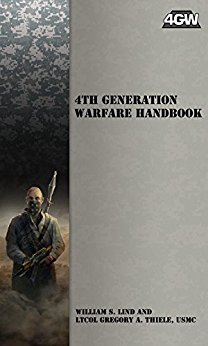|
The 4th Generation Warfare Handbook
by William S Lind and Lt. Col. Gregory A. Thiele Published in November 2015 134 Pages Thibault’s Score: 4/5 The 4th Generation Warfare Handbook is certainly an extremely interesting book, and one that I strongly recommend to anyone who is interested in studying geopolitics. Many things about this book surprised me. First, was the writing style. I was expecting the book to read like the Army’s Survival Handbook which I read several years earlier. Instead of a dry technical white paper (which I was expecting), Lind uses allegory in the same style as Clausewitz’s on war. He gives numerous extensive anecdotal stories, and works hard to put the reader in the shoes of a combatant of 4th Generation Warfare. Another thing which surprised me was Lind’s definition of 4th Generation Warfare. It differs greatly from what I’ve read on Wikipedia and elsewhere, but makes much more sense. Out of fear of butchering the explanation of 4th Generation Warfare that I still don’t fully understand, I will let the reader discover this for themselves. The only (very minor and perfectly understandable) factor that might make this book boring to some readers is the fact that the last few chapters of the book are written for a modern commander who is actively training his troops for a military engagement. Several things about 4th Generation Warfare and its implications struck me as particularly remarkable. Lind’s explanation about why the counter-insurgencies often fail make perfect sense. The rules of 4th Generation Warfare turn all convention 2nd and 3rd generation strategies on their head. When the distinctions between states and non state actors, between soldiers and civilians, or between moral and immoral become blurred, all of the rules of warfare are changed. In traditional wars, the side which takes the most casualties wins, while the side that takes the least loses. In traditional wars, you wing by applying the maximum rather than the minimum amount of force. In traditional wars, defense is key, and consolidating your forces is critical. In the 4th Generation of War, all of these old fashion rules of conflict have been turned on their head. Lind gives several very interesting imaginary anecdotes between fictional commanders in Iraq applying the tradition “Goliath” strategy and Lind’s “David” strategy. This anecdote has completely changed by understanding of the Iraq war, and helped me realize that to beat an insurgency it is critical to become more like an insurgency. I also found the chapter which enumerates the differences between line infantry and light infantry to be fascinating. I had always heard of the two but never really understood the differences. This helped me realize the key tactical difference between the wars of tomorrow and yesterday. I also now realize that the vast majority of potential soldiers who could fight in Line Infantry aren’t cut out to fight as Light Infantry. For example, I might survive (but hate) a time in Line Infantry, but am not mentally or physically able to fight as Light Infantry. The wars of tomorrow will rely on decentralized networks of highly specialized and elite soldiers rather than masses of conscripts. William S Lind is truly a modern day Clausewitz.
1 Comment
Warfare is such an interesting topic in my opinion. I have always been a great fan of Sun Tzu, the Chinese general. He was one of the best when it comes to wars and tactics. He has led the Chinese army to many victories in his time as head strategist. He had written a marvelous book which described his way of war. In his book, he stated almost all of the schemes he had formulated in his long service career.
Reply
Leave a Reply. |
Thibault SerletMost of my articles are book reviews, but I also write about many other topics. Archives
December 2023
Categories |

 RSS Feed
RSS Feed